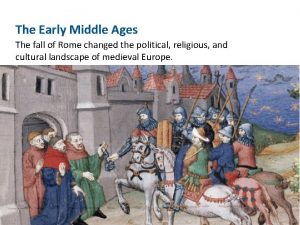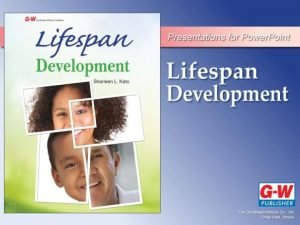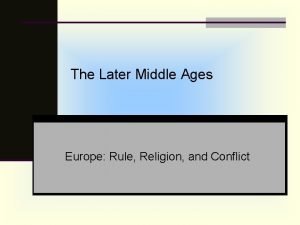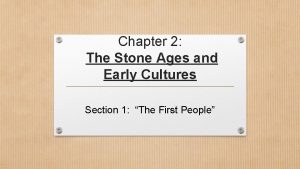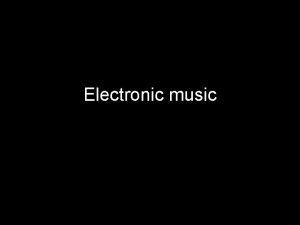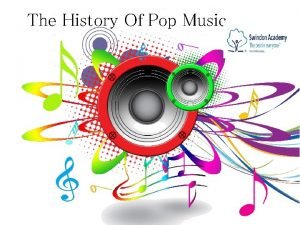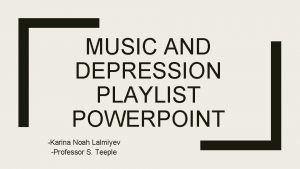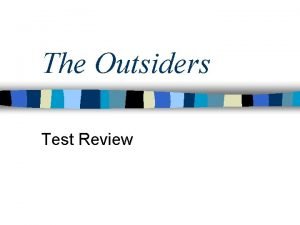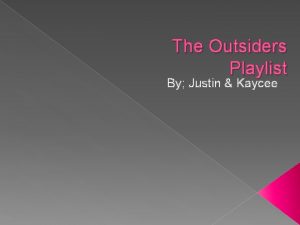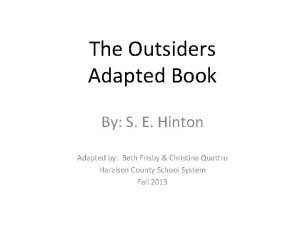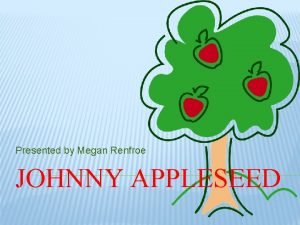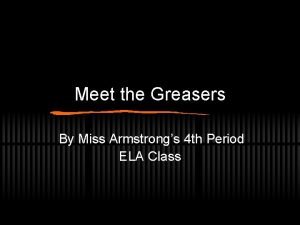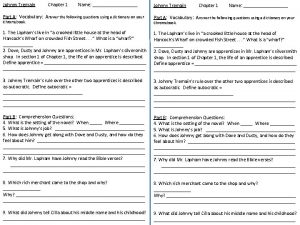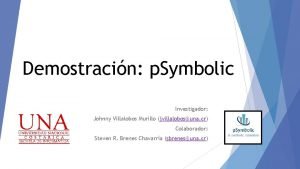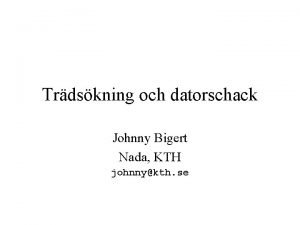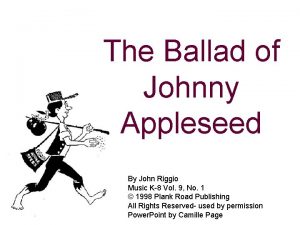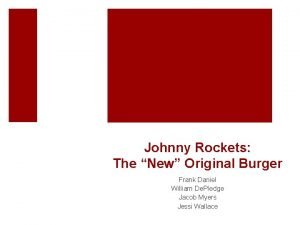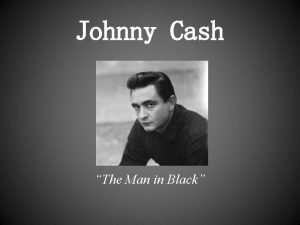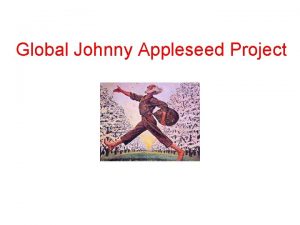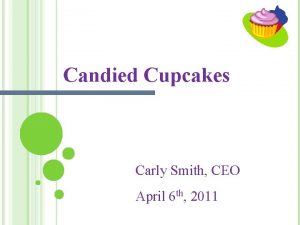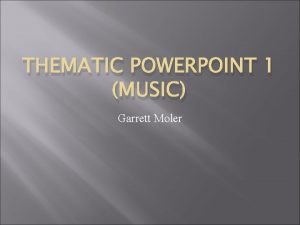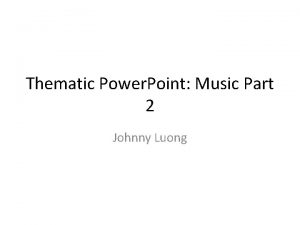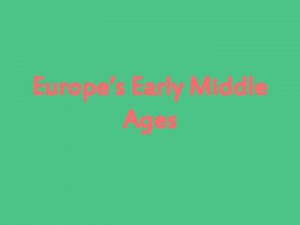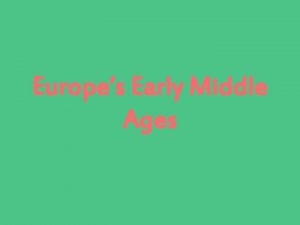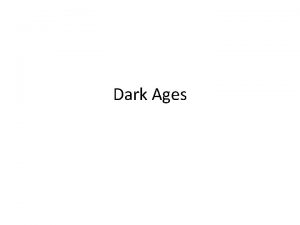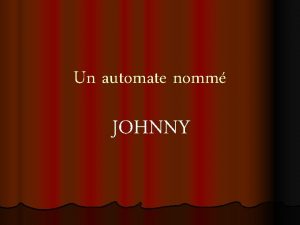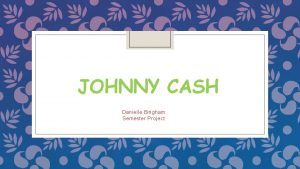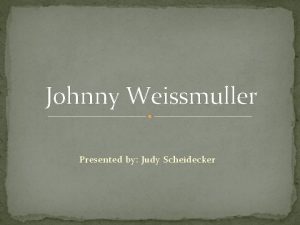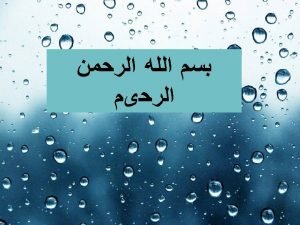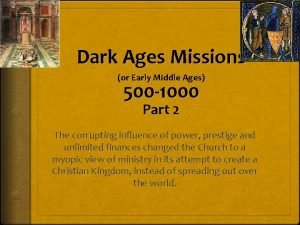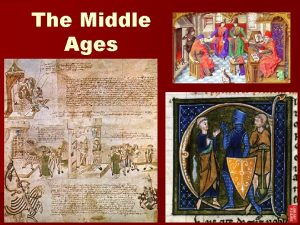Thematic Powerpoint Music in the early ages Johnny


































- Slides: 34

Thematic Powerpoint Music in the early ages Johnny Luong

European Music � � � Renaissance music is European music written during the Renaissance (a cultural movement that spanned roughly the 14 th to the 17 th century) Madrigals were secular (not religious) songs, usually love songs, that were sung in multiple parts without any instrumental accompaniment Instrumental music was specifically written for instruments only Much of the instrumental music of the time was written in a polyphonic form Multiple instruments would be played in a song (one plays, then the other follows throughout the songs, then more come in as the song progresses) Dance music was very popular for instrumentalists The development of Church introduced secular songs European music differed from other cultures because they had more technology to create instruments that played well There were two forms of church music. These two forms were the 'mass' and the 'motet' The mass is a musical setting, which is usually performed during the celebration of the Eucharist in the Roman Catholic Church music expressed human feelings, emotions, and moods

West African Music � � � � Drums Moving both feet and body Fast beats Wild dancing Instruments such as the djembe, tama, and sabar were used (drums) Vocal music and songs are an important part of all West African cultures Choral music is generally sung in unison or octaves in West Africa’s musical rhythm: a steady tempo is divided into pulses-the smallest units of rhythm-that serve as a way of orienting time Groups of pulses are organized by beats every 3, 4, 6, 8, or 12 pulses Actual instrumental parts and song melodies are then organized by cycles, repeating patterns that usually last 8, 16, or 24 beats This complexity is usually held together by a time line, which is a steady, repeating (though usually syncopated) pattern played on a bell, sticks, or the side of a drum. Music often accompanies religious rituals or ceremonies that mark cycles of life, such as birth, puberty, weddings, and funerals Young males are sometimes taken away from their families to learn their new social roles learning special songs and instruments that they would play upon their return Many places women coordinate pounding millet with a mortar and pestles to produce rhythmic patterns Musicians sometimes played for politic reasons. They would play songs of praise and stories of the history of the ruling family Drums were the defining element of West African music

Native American Music � � � � � The Inca had a genre of historical songs, while the Aztec carved symbolic pictures onto some instruments indicating how, when, where, and by whom they were played Chanting/praying Traditional tribal music Gender played an important role in Native American music Instruments, songs and dances are often peculiar to one or the other sex, and many musical settings are strictly controlled by sex The Iroquois water drum is a small cup-shaped wooden vessel, with water inside it, and a moistened tanned hide stretched across the top opening; the wetness and tightness of the tanned hide produce changes in pitch as the water drum is played over time The Yaqui type of water drum is actually a half gourd, large in size, that floats in a tub of water like a bubble on the surface; the outer round surface of the gourd is struck with a drum stick, and the vibrations are amplified using the tub of water as a resonator. For the Native American, song is traditionally the chief means of communicating with the supernatural powers, and music is seldom performed for its own sake; definite results, such as the bringing of rain, success in battle, or the curing of the sick, are expected from music There are three classes of songs—traditional songs, handed down from generation to generation; ceremonial and medicine songs, supposed to be received in dreams; and modern songs, showing the influence of European culture

Renaissance Music � During the Renaissance, printing made music more widely available � A type of vocal music called a motet was developing during the end of the Middle Ages and came into real importance during the Renaissance � Madrigals were very popular during the Renaissance period � Most instruments during the Renaissance period were string instruments � The most popular and most played instrument during the period was the lute � The Renaissance time period was one of the most productive time periods because of the advancement of music

Combined Music Structure in the 1400 -1600 s � All three types of music both shared similar rhythm taste and differences. The West African and Native Americans were similar in how the beats were played and how their style was displayed as of Europeans displayed more of a joyful taste in music and how calm and unique their instruments were than the other two cultures.

Baroque music � � � � � Oral cultures, depending on the transmission of information by the spoken word rather than through print, on the passage of traditions through storytelling and song, music and crafts. Baroque music is a type of European classical music approximately extending from 1600 to 1750. This music age began this type of music after the Renaissance and was followed by the Classical era. The word “baroque” came from the Portuguese word barroco, meaning “misshapen pearl. ” Baroque music forms a major portion of the classical music canon, being widely studied, performed, and listened to. A few composures who performed baroque music are Johann Sebastian Bach, George Frideric Handel, and Alessandro Scarlatti. Music described as Baroque is a broad range of styles from a wife geographic region, mostly in Europe, composed during a period of approximately 160 years. The Baroque suite generally began with a French overture. The allemande was a very popular dance that had its origins in the Renaissance era, when it was more often called the almain. Baroque music shares with Renaissance music a heavy use of polyphony and counterpoint.

Music in the 1700 s The 17 th century was the golden age of the organ in Germany. � The organ of Germany was a period when English and Italian advances in keyboard forms and techniques were grafted onto an already vigorous German keyboard style. � Germany has been known since the eighteenth century for music of high quality and serious purpose, as the fame of Bach, Handel, Beethoven, and Wagner. � During the 17 th century, German composers began the process of assimilating foreign genres and techniques to the needs of the German Lutheran liturgy, with its popular hymns or chorales. � Germany’s magnificent instruments that inspired an unparalleled interest in music for the King of Instruments during the Baroque era. �

Classical Period � � � � The Classical period in Western music are generally accepted as being between 1750 to 1820. The term classical music is used colloquially to describe a variety of Western musical styles from the ninth century to the present, and especially from the sixteenth or seventeenth to the nineteenth The classical period falls between the Baroque and the Romantic periods. In the middle of the 18 th century, Europe began to move towards a new style in architecture, literature, and the arts, generally known as Classicism. It moved towards a style where a melody over a subordinate harmony, a combination called homophony, was preferred. Nobility became the primary patrons of instrumental music, and there was a rise in the public taste for comic opera. The simplification of texture made such instrumental detail more important, and also made the use of characteristic rhythms, such as attention-getting opening fanfares, the funeral March rhythm, or the minuet genre, more important in establishing and unifying the tone of a single movement. Classical music has a lighter, clearer texture than Baroque music and is less complex.

Melodies �A sweet melody for classical music made the tonal structure of works more audible. � This new style was pushed by changes in the economics order and in social structure. � Classical music was mainly homophonic. � Variety and contrast within a piece became more pronounced than before. � Variety of keys, melodies, rhythms and dynamics, along with frequent changes of mood and timbre were more commonplace in the Classical period than they had been in the Baroque. � Melodies tended to be shorter than those of Baroque music, with clear-cut phrases and clearly marked cadences.

Importance of Classical Music � � � � The main kinds of importance in music were sonata, trio, string quartet, symphony, concerto, serenade, and divertimento. The most important and prevalent type of serenade in music history is a work for large instrumental ensemble in multiple movements, related to the divertimento, and mainly being composed in the Classical period. The most famous examples of serenade from the 18 th century are by Mozart In church music and opera, up to the end of the 18 th century, the castrato voice is widely considered the most thrilling sound in music, bringing fortunes to the singers themselves. Opera was the ruling 17 th century form, and French composers wrote operas of a uniquely French type. French composers combined elements of opera, ballet, and spoken drama in a form sometimes called opera-ballet. French harpsichord music of the baroque period was of high quality. It consisted mostly of suites of dance movements and short character pieces rather than the longer preludes and fugues, toccatas, and fantasias cultivated by the Germans. Opera started in Italy at the end of the 16 th century. In the 18 th century, Italian opera dominated most of Europe, except France. The words of an opera are known as the libretto (meaning little book) Opera was elevated in tone and highly stylized in form, usually consisting of secco recitative interspersed with long da capo arias. Farinelli was the most famous singer of the 18 th century. Italian opera set the Baroque standards.

Terms � � � Serenade – a musical composition, a performance, in someone’s honor. Serenades are typically calm, light music. Overture - a musical form widely used in the Baroque period. It is in three parts: the first is slow, often with over-dotted, the second is quick and fugal, and the first part returns at the end. Alman - is one of the most popular instrumental dance forms in Baroque music, and a standard element of a suite. Originally, the allemande formed the first movement of the suite, before the courante, but, later, it was often preceded by an introductory movement, such as a prelude. Classicism - in the arts, refers generally to a high regard for classical antiquity, as setting standards for taste which the classicists seek to emulate. Baroque music - describes a style of European classical music approximately extending from 1600 to 1750. Development of functional tonality

Jacob Arcadelt � Wrote madrigals, masses, chansons and motets � Musical work: Published 6 books of madrigals for 5 voices and three volumes of masses for 3 to 7 voices along with 24 motets and 126 French chansons. � Born: Belgium 1500 s, died on October 14, 1568 in Paris � Composer of secular vocal music � Arcadelt was a singer and later a choirmaster in the papal chapel in Rome (1539– 49), and he subsequently spent time in France and again in Italy. He entered the service of Charles, duc de Guise, in 1555 and in 1557 was a member of the French royal chapel.

Thomas Tallis � 1510 -1585 � Thomas Tallis, an English composer, flourished as a church musician, and is considered one of the church's best early composers. Tallis served under four English Monarchs and was treated very well. Queen Elisabeth granted him and his pupil, William Boyd, exclusive rights to use England's printing press to publish music; a first of its time. Although Tallis composed many styles of music, the majority of it is arranged for choir as Latin motets and English anthems.

Wolfgang Amadeus Mozart � 27 January 1756 – 5 December 1791 � Was a prolific and influential composer of the Classical era � He composed over 600 works, many acknowledged as pinnacles of symphonic, concertante, chamber, piano, operatic, and choral music � Austrian composer and pianist � Many people think he was one of the best composers of music of all time � He was born in the city of Salzburg

Giuseppe Domenico Scarlatti � Naples, 26 October 1685 – Madrid, 23 July 1757 � Was an Italian composer who spent much of his life in the service of the Portuguese and Spanish royal families � He is classified as a Baroque composer chronologically, although his music was influential in the development of the Classical style. � Today he is known almost exclusively for his 555 keyboard sonatas.

Ludwig van Beethoven � 17 December 1770 – 26 March 1827 � Was a German composer and pianist. He is considered to have been the most crucial figure in the transitional period between the Classical and Romantic eras in Western classical music, and remains one of the most famous and influential composers of all time.

Franz Joseph Haydn � 31 March 1732 – 31 May � Was an Austrian composer, one of the most prolific and prominent composers of the classical period. � He is often called the "Father of the Symphony" and "Father of the String Quartet" because of his important contributions to these genres. � He was also instrumental in the development of the piano trio and in the evolution of sonata form.

Questions � 1. What was the important era for European music? � Renaissance Era � Columbus Era � Middle Ages � Industrial Revolution � 2. Which culture had the defining element of music in drums? � Europeans � West Africans � Australians � Native Americans

Questions � 3. What introduced secular songs? � The Pope � The Church � Dance ceremonies � Orchestras � 4. True or False: The mass is the musical setting which is usually performed during the celebration of some churces � True � False

Questions � 5. Out of all the cultures, which one was most influenced by religion? � West Africans � Canadians � Native Americans � Renaissance � 6. What was the most popular instrument played during the Renaissance? � Flute � Lute � Trumpet � Saxophone

Questions � 7. Whom did the Inca come from? � Native Americans � Aztecs � Europeans � Spain � 8. Which culture had the smoothest and calm music taste? � The Church � Native Americans � Incas � Europeans

Questions � 9. True or False: For Native Americans, songs were initially used to be played for farming and hunting for food and at night, they sacrificed the animals they slaughtered with the help of musical beats playing. � True � False � 10. True or False: West Africa’s musical rhythm consists of steady tempos. � True � False

Questions � 11. Where does the word “baroque” come from? � Portuguese � England � Germany � Italian � 12. Which country was known for high quality music? � England � Italy � Germany � Spain

Questions � 13. True or False: The most famous examples of serenade from the 18 th century are by Mozart � True � False � 14. What new style of art was being developed in the 18 th century? � Boroque Era � Classicism � Renaissance � Music Theory

Questions � 15. Which type of opera dominated most of Europe? � German � Italian � English � American � 16. What do the words of the opera mean? � Little book � Serenade � Dancing and performing � Melody of high class

Questions � 17. Who was the most famous singer of the 18 th century? � Mozart � Beethoven � Farinelli � 18. What is an overture? � Music form in Classicism � Form in Boroque � A piano � A type of genre relating to music based on slow melodies, fast singing, and repetitive dancing

Questions � 19. True or False: French harpsichord music of the baroque period was of low quality � True � False � 20. True or False: Mozart produced over 600 pieces of work. � True � False

Questions � 21. True or False: Franz Joseph Haydn was a composer of the classical period. � True � False � 22. True or False: Beethoven was professional in sheet music � True � False

Questions � 23. Music notation was written in what? � Symbols � Language � 24. True or False: Sheet Music comes in different formats. � True � False

Question � 25. Jazz used what type of basic indication? � Melodies. � Chord Changes � Arrangements � All of the above � 26. True or False: Sheet music can be used as a record of, a guide to, or a means to perform, a piece of music. � True � False

Questions � 27. Sheet music is a hand-written or printed form of musical rhythm � True � False � 28. Yankee Doodle was a song made by a British man named Richard Shalman � True � False

Questions � 29. A vocal score is a reduction of the full score of a vocal work � True � False � 30. Lead sheet is commonly used in popular music to capture the essential elements of song without specifying how the song should be arranged or performed. � True � False

Answers � � � � � � � � 1. A 2. B 3. B 4. A 5. C 6. A 7. D 8. B 9. A 10. A 11. A 12. C 13. A 14. B 15. B 16. A 17. C 18. B 19. B 20. A 21 A 22. A 23. A 24. A 25. D 26. A 27. B 28. B 29. A 30. A
 Dark ages vs middle ages
Dark ages vs middle ages Dark ages vs middle ages
Dark ages vs middle ages Online music portfolio
Online music portfolio Theme vs thematic statement
Theme vs thematic statement Early middle ages
Early middle ages Chapter 7 early childhood ages 3 through 5 answer key
Chapter 7 early childhood ages 3 through 5 answer key Early middle ages
Early middle ages The stone ages and early cultures
The stone ages and early cultures Sacred music in the middle ages
Sacred music in the middle ages Early cpr and early defibrillation can: *
Early cpr and early defibrillation can: * Tondo theater 1841
Tondo theater 1841 Hawaii early learning profile
Hawaii early learning profile Vocal music of the romantic period
Vocal music of the romantic period Beats organized into recognizable/recurring accent patterns
Beats organized into recognizable/recurring accent patterns A music that employs electronic musical instruments
A music that employs electronic musical instruments Pamulinawen instrument used
Pamulinawen instrument used The history of pop music
The history of pop music Powerpoint presentation on topic music
Powerpoint presentation on topic music Exposition the outsiders
Exposition the outsiders Outsiders playlist project
Outsiders playlist project Dally and sodapop
Dally and sodapop Johnny brown
Johnny brown How to make a johnny appleseed hat
How to make a johnny appleseed hat What is dally's physical description
What is dally's physical description Johnny tremain chapter 3
Johnny tremain chapter 3 Johnny cupcakes blog
Johnny cupcakes blog Father knows least
Father knows least Johnny villalobos
Johnny villalobos Johnny bravo 1995
Johnny bravo 1995 Datorschack
Datorschack Johnny appleseed bag
Johnny appleseed bag Johnny rockets fresno
Johnny rockets fresno Man in black johnny cash meaning
Man in black johnny cash meaning Johnny appleseed project
Johnny appleseed project Johnny cupcakes net worth
Johnny cupcakes net worth




